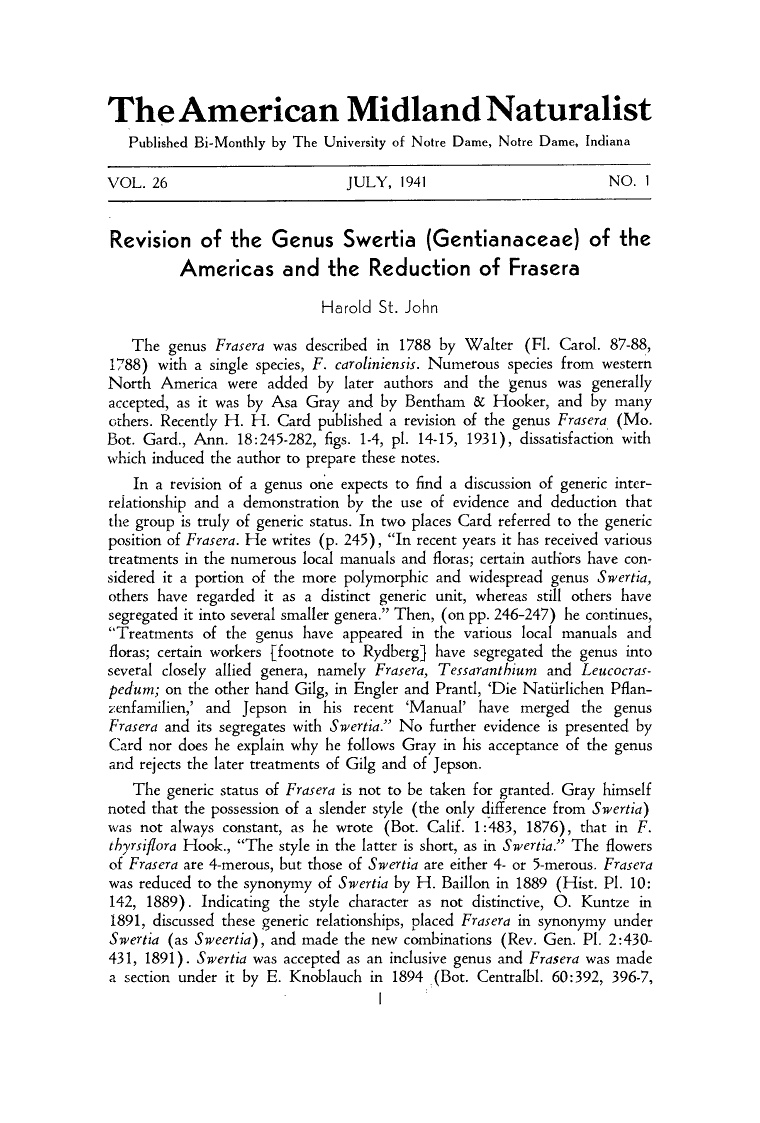 Eastern Mojave Vegetation
Eastern Mojave Vegetation
 Eastern Mojave Vegetation
Eastern Mojave Vegetation
| St. John, 1941 |
|
|

If you have a question or a comment about this photograph you may write to me at: tomas@schweich.com I sometimes post interesting questions in my FAQ, but I never disclose your full name or address. |

Revision of the Genus Swertia (Gentianaceae) of the Americas and the Reduction of Frasera Harold St. John The genus Frasera was described in 1788 by Walter (FL Carol. 87-88, 1788) with a single species, F. caroliniensis. Numerous species from western North America were added by later authors and the genus was generally accepted, as it was by Asa Gray and by Bentham & Hooker, and by many others. Recently H. H. Card published a revision of the genus Frasera (Mo. Bot. Gard., Ann. 18:245-282, figs. 1-4, pl. 14-15, 1931), dissatisfaction with which induced the author to prepare these notes. In a revision of a genus one expects to find a discussion of generic interrelationship and a demonstration by the use of evidence and deduction that the group is truly of generic status. In two places Card referred to the generic position of Frasera. He writes (p. 245), "In recent years it has received various treatments in the numerous local manuals and floras; certain authors have considered it a portion of the more polymorphic and widespread genus Swertia, others have regarded it as a distinct generic unit, whereas still others have segregated it into several smaller genera." Then, (on pp. 246-247) he continues, "Treatments of the genus have appeared in the various local manuals and floras; certain workers [footnote to Rydberg] have segregated the genus into several closely allied genera, namely Frasera, Tessaranthium, and Leucocraspedum; on the other hand Gilg, in Engler and Prantl, 'Die Natürlichen Pflanzenfamilien,' and Jepson in his recent 'Manual' have merged the genus Frasera and its segregates with Swertia." No further evidence is presented by Card nor does he explain why he follows Gray in his acceptance of the genus and rejects the later treatments of Gilg and of Jepson. The generic status of Frasera is not to be taken for granted. Gray himself noted that the possession of a slender style (the only difference from Swertia) was not always constant, as he wrote (Bot. Calif. 1:483, 1876), that in F. thyrsiflora Hook., "The style in the latter is short, as in Swertia." The flowers of Frasera are 4-merous, but those of Swertia are either 4- or 5-merous. Frasera was reduced to the synonymy of Swertia by H. Baillon in 1889 (Hist. Pl. 10: 142, 1889). Indicating the style character as not distinctive, O. Kuntze in 1891, discussed these generic relationships, placed Frasera in synonymy under Swertia (as Sweertia), and made the new combinations (Rev. Gen. Pl. 2:430431, 1891). Swertia was accepted as an inclusive genus and Frasera was made a section under it by E. Knoblauch in 1894 (Bot. Centralbl. 60:392, 396.7,
Other photos about Frasera albomarginata or Taxonomy.
|
|
Date and time this page was prepared: 3/23/2025 6:12:16 PM |